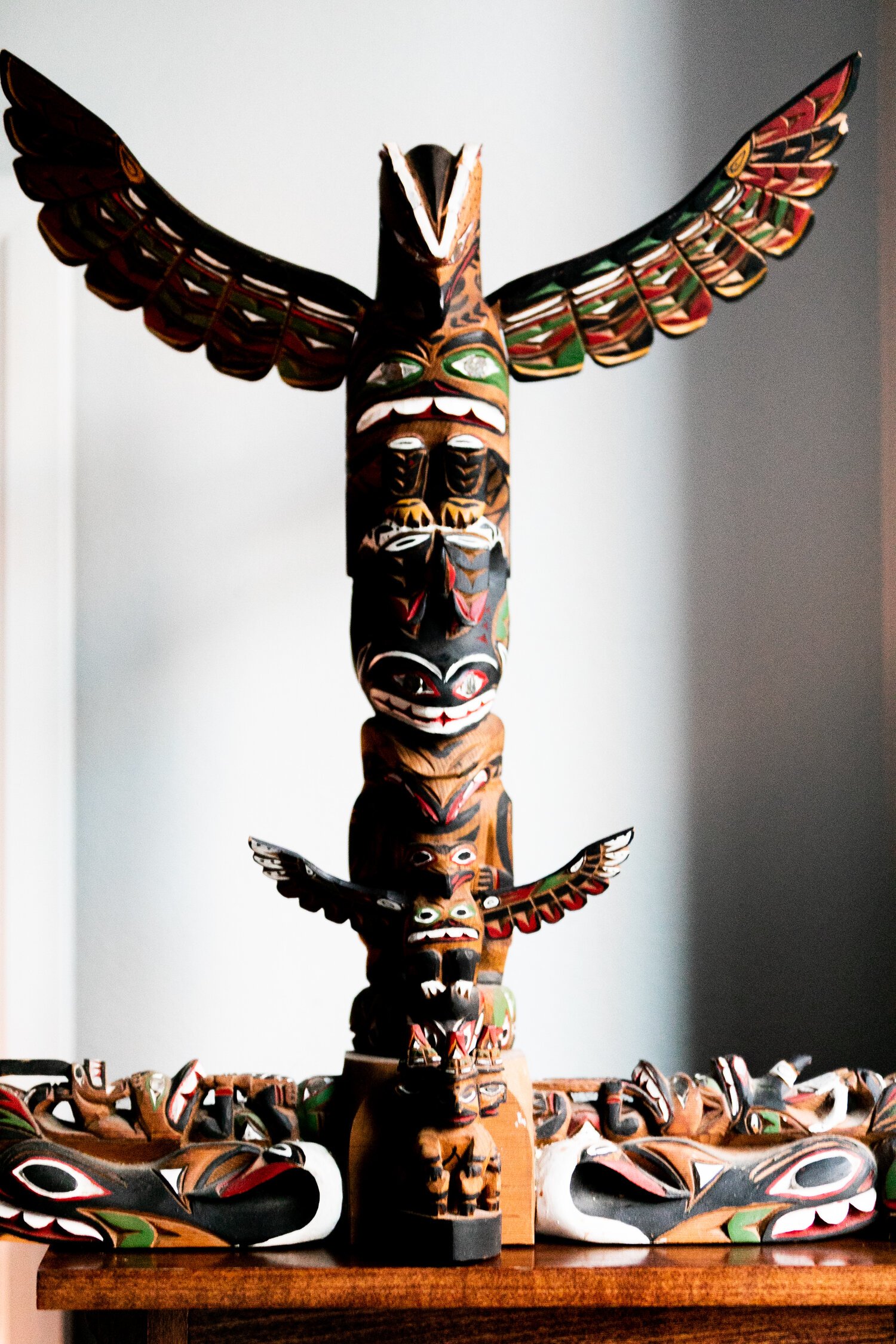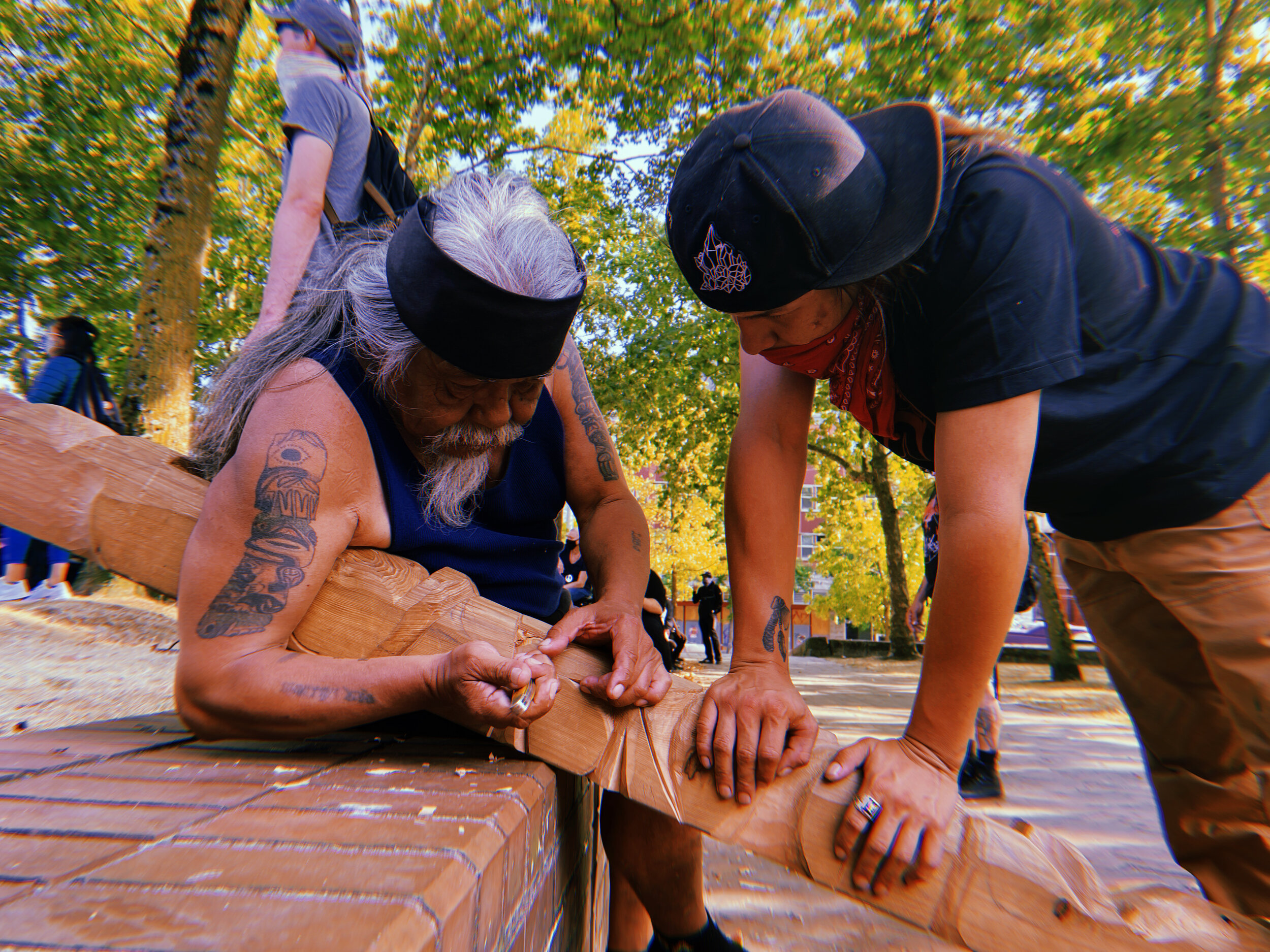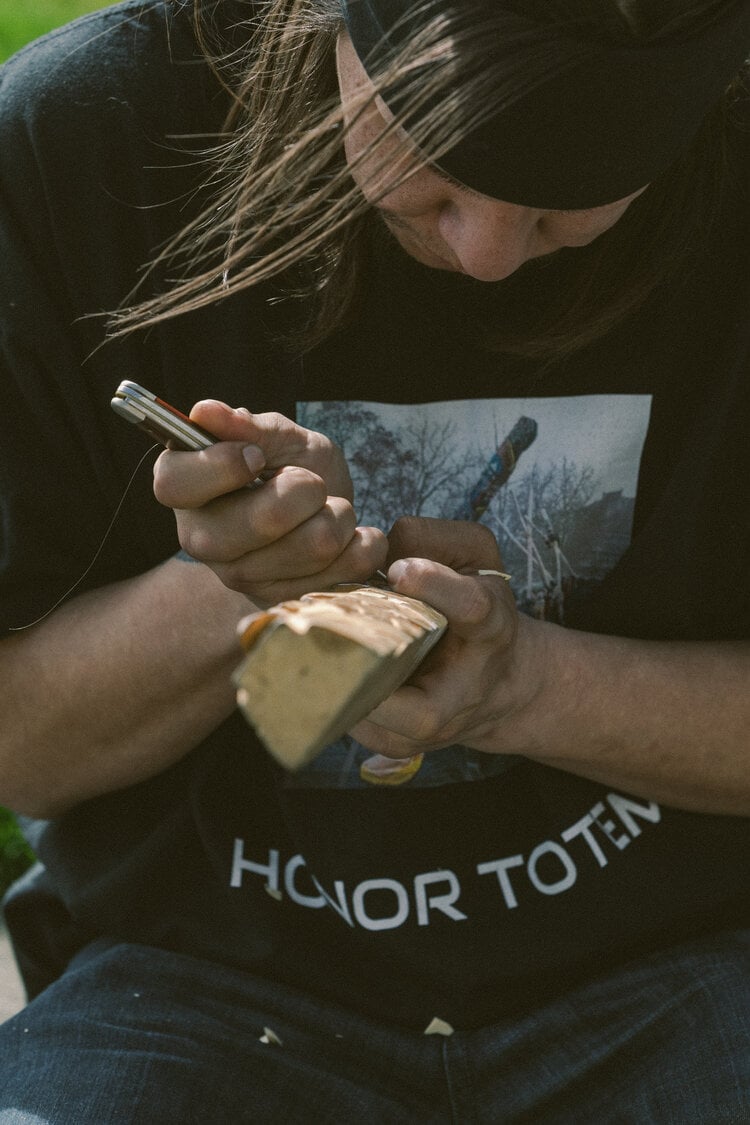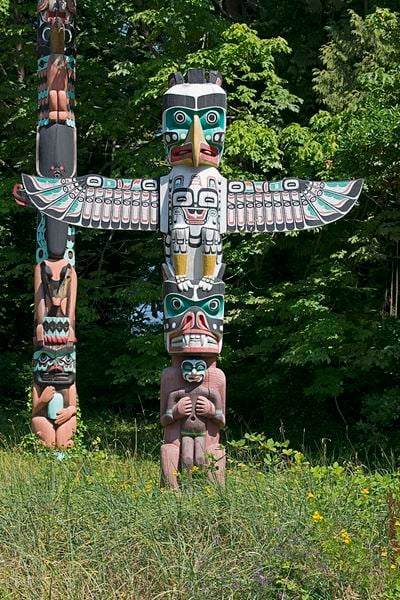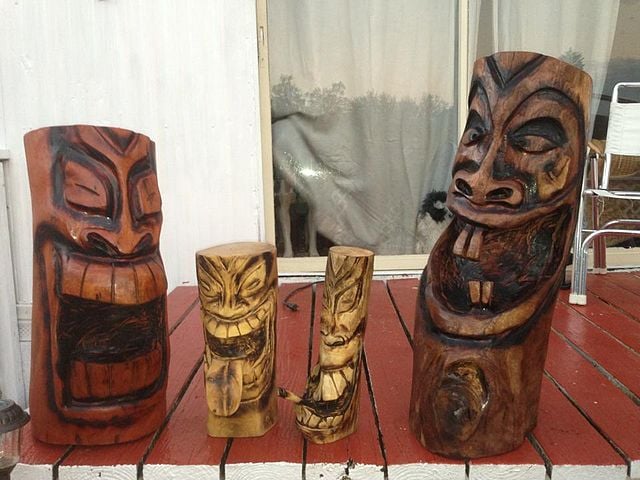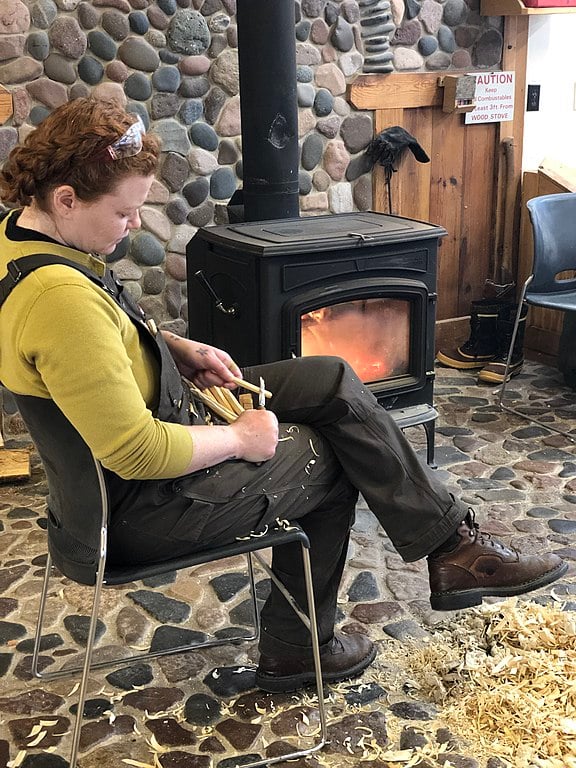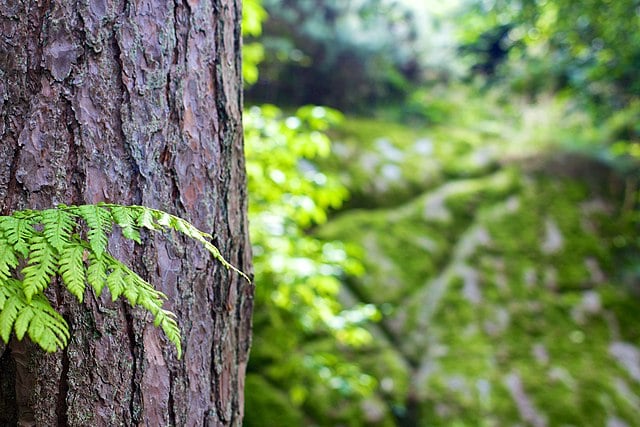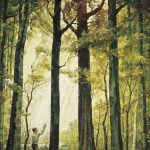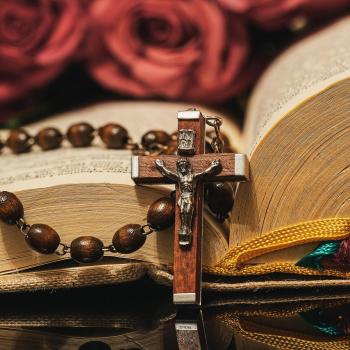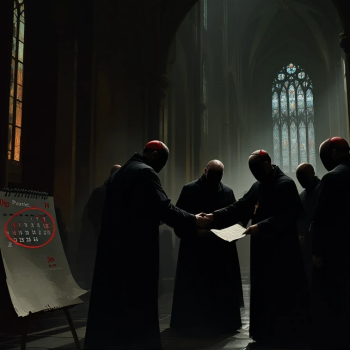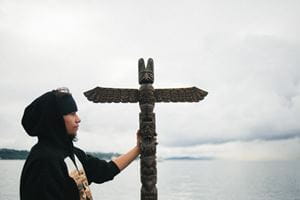
“Religion Behind the Scenes” spotlights the less discussed, but no less crucial, tasks that keep religious communities running, and the people who make it all happen.
There are a handful of things which Anglos stereotypically associate with the First Nations peoples of North America. Whether that’s the “warbonnets” occasionally worn by some in the Sioux and Cherokee tribes, the teepees of the Great Plains tribes, or the “rain dance” of the Navajo and Hopi—movies and novels have created images of First Nations peoples that are not always accurate, or which confuse the practices and peoples of the various groups who identify as First Nation. One such element, often misunderstood and not universally used among Native Americans, is the totem pole. Sacred and symbolic, the Williams family (currently of Seattle) have been making these monumental carvings for 8 generations.
EagleSon Williams and his father, Lone Wolf, are members of the Nuu-chah-Nulth of Ditidaht First Nation—and part of the Thunder Bird Longhouse. EagleSon has been carving totem poles for nearly a quarter of a century, being taught by his father, who was taught by his father (utilizing the carving style of the Nitinat tradition). The Williams Family Carvers have been a feature in Seattle for more than a century.
In this installment of Religion Behind the Scenes, we’ll learn a bit about First Nation totem poles, how they are made, who makes them, how they’re used, and what power and influence they can have, not just on Native Americans or First Nations peoples, but upon any who understand and believe in the mystical energy they contain.
What exactly is a totem pole? What's its purpose among First Nations peoples?
It’s a symbol of our people, our clan, or ancestors. Back in the day, totem poles were used to tell “What's your longhouse?” or “Who's your tribe?” You know, “What’s your weapon?” Of course, totem poles were meant to be in front of your tribe to identify it and explain it or to define it—but also to help you find your way home. They can represent some event or tribe, some ancestor or power we have or want to have—or need.
Totem poles help us spiritually. That’s the first thing. Second, they keep our hands busy, which actually keeps us out of trouble. If you’re busy you’re not doing bad. They’re also a way of teaching our tradition and culture, if we choose to teach it to those who are not of a First Nation clan or tribe.
I know you're an eighth-generation totem pole carver, but how far back in history does the use of totem poles go? Do you know?
Last I checked, the oldest ones dated back to the 1800s. They’re made of wood, so it is hard to tell how far back the practice of making them goes—because the oldest ones wouldn’t have survived. But, last I checked, there were totem poles that were from the 1800s which still exist today. So, we know that First Nations peoples have been making them for hundreds of years (at least)—and probably longer. I don’t think the 1800s is the earliest use of them, but it’s the earliest that I know of that their use can be “proved.” Again, carved wood only lasts for so long. So, they don’t survive, and we just can’t say when they were first used.
My family has been carving totem poles for a little over 200-years. So, that much I can say for sure.
Do you know which tribes actually carve or use totem poles?
Mostly First Nation tribes from the Northwest Coastal Region—like Canada and Alaska. I mean, you have different kinds of totem poles, like the memorial poles or ones used inside the house or different ones for outside of the house. You’ve got ones associated with graves, sometimes called “mortuary poles.” You’ve got what some people call “shame poles” or “ridicule poles.” You have small polls and very large poles. So, different tribes and different clans might use one kind of pole and not another kind. And people often don’t understand the difference between a totem pole and a tiki (that you see among the Hawaiians or Mauris), and stuff like that.
Are there certain places a person would use or place a totem pole?
Yeah. People’s homes. In a sweat lodge. You’ll see them in stores owned by First Nation peoples, or in a store that sells things made by First Nation peoples. We had one store that’s been buying totem poles from my family since 1906. They wanted us to mass produce a specific totem pole for them, but we don’t mass produce them. Each is unique. And there are more than 250 totem pole designs.
There are over 250 designs?
Of course. When you think about every critter, every bird or species on this earth that could be incorporated into a totem pole, there are tons of potential designs. We pretty much carve all of those. I’ve probably carved between 170 and 175 different designs.
So, how does a totem pole carver know what to carve? How do you decide what the totem pole should look like?
Well, back home in Canada, for example, the Black Rock had a practice. What they did is pretty much whatever animal came to them, they carved it into a totem pole.
The Thunderbird, my clan, have done the same. I remember my uncle (who has since died) was sitting by the water and a kingfisher came up to him. So, he carved it. In our culture, if an animal comes up to you and it has not been carved yet, if you carve it, then that piece is yours.
You’ve suggested that there are different kinds of totem poles. Can you say a bit more about that?
Yeah. Of course, you have the basic totem poles (that are pretty simple or basic in design), then you have what you might call a “midway” totem pole (which would be a bit more detailed), and then there are the ones that are supper detailed or fancy, with lots of detail work carved into them.
But there are also different kinds related to the design and the symbolism incorporated—which changes the meaning and purpose of the totem pole.
Every totem pole and every design are different. There’s always a different story behind a totem pole, and a different propose for a specific totem pole. So, for example, we have this one that’s called a “Chief Speaker” totem pole. And let's say we're in a meeting and we can't decide on something. Perhaps everyone is disagreeing as to what we should do. Well, you would use the “Chief Speaker” totem pole, all those present in the meeting would pass the totem pole around. And basically, everyone sits quietly and lets the one person speak who is holding the “Chief Speaker” totem pole. And then, once he has had his say, he passes the totem pole on to the next person. And he gets to speak, and so on and so forth. So, all opinions and ideas are heard, and this way there are no arguments. It's an agree to disagree type of deal. But this can also help to work out the problem and the disagreements in a calm and peaceful way. So, that’s the purpose of that specific totem pole.
Different totem poles have different meanings and even different purposes—and giving a totem pole to someone can have a specific meaning as well. So, for example, if were to give a totem pole as a gift to a member of another First Nation tribe, that would be a big honor; I am showing them honor or respect by giving that. It may be a sign of appreciation that they let me be in their space, or appreciation that they have hosted me in their home, or something like that.
Are there major symbols that are traditionally incorporated into most totem poles—standard symbols that are usually used?
Well, for me, my standard is a bear. I use that one a lot. A lot of people need strength these days to keep pushing forward. Different carvers may have a specific symbol they are drawn to, like an eagle, a kingfisher, a mother raven, or whatever.
Some symbols are more negative, and some are more positive. So, for example, ravens, crows and owls. Those are often negative symbols and can be negative omens. When I was a kid, they would say that if a raven comes, then something bad is going to happen to a family member—usually your mother or grandmother. So, it kind of symbolized bad luck. For white people, an owl is sometimes thought to be a symbol of wisdom. But, in certain First Nation tribes, it represents the idea that you either learn a valuable lesson or someone is going to die that night. So, if it approaches you, it can’t talk, but it is trying to tell you something—and that’s usually seen as a bad omen or a warning. So, an owl is not usually a good symbol.
Related to the previous question, beyond the “traditional” symbols, does each totem pole have some kind of specific symbolism associated with it?
Yup! Just like I talked about with the bear earlier.
Of course, some will want a specific pole because of the animals it has on it and what those symbolize. Sometimes someone will want a specific totem pole because they saw it and it just called out to them, and they fell in love with it. So, there are various reasons why someone would want to have a specific totem pole. Sometimes it’s the symbolism and what it means. Sometimes it’s just that they felt some spiritual connection to the pole.
Is there something that authorizes somebody to be a totem pole maker?
Yeah. So, I teach non-Natives how to carve them, but I’ll tell them, “You can do this as a hobby, but you can’t make money doing this.” And they’ll always ask, “Why is that?” And I’ll tell them that I am First Nation, and most people are not. I come from a royal bloodline. Most people are not.
There are lots of First Nation clans: Raven clans, Wolf clans, every different clan. I’m Thunderbird. Some think a Thunderbird is just like an eagle, or something. But the ancient Thunderbird averaged over 150 pounds and its wingspan measured nearly 23 feet from tip to tip. It was big enough to take an orca whale from the sea and then fly off with it like it was holding a fish.
Anyway, to make a totem pole and then sell it as a First Nation artifact, you must be a descendant of one of the First Nation clans. Otherwise, it is inauthentic, and you may actually be breaking the law by selling it—if you try to pass it off as authentic First Nation art. You don’t have to be First Nation to make and sell totem poles. You can be any kind of Native American. But if you're not native, and you're trying to sell them, you could get in trouble with the Bureau of Indian Affairs. So, for example, two people that I know are probably going to prison for 10-15 years because they’ve been selling non-Native totem poles and claiming that they were carved by Native American. They were claiming they were authentic and antique Native American totem poles, and this and that. And they got caught and got in big trouble for it. There are actually laws governing these things.
Can a woman carve a totem pole if she's First Nation?
Oh, yes. My aunties were the best carvers.
What are totem poles typically carved out of?
Oh, Red Cedar, Yellow Cedar, Sugar Pine. Just about any kind of wood, except for wood from the sea, because the sea water will get rocks in the wood (in due time), and that makes it hard to carve and can ruin your knife as you carve.
I don’t really have a certain wood that I prefer to work it. I basically like them all. I mean, if someone said I could choose, I guess I would pick Red Cedar, but I can carve pretty much anything.
And what do you paint them with? Do you use just normal paint or some kind of special paint?
Back in Canada, I would make my own paint. I know how to make the paint our ancestors would have used. I can’t make that here in Seatle because I don’t have access to the materials I need to make it, so I have to use store-bought paints here. But originally, we made our own paints and stains for the totem poles. If I try to make the hand-made paint out of what’s available her in Washington state, it doesn’t have the right texture. So, I just purchase it from a store.
Walk us through the process of making a totem pole. What does that look like?
Well, you need to get a good piece of wood that’s got the right shape and size and is in good condition. So, like I said earlier, you don’t want to use a piece of driftwood from the sea, or a piece of wood that’s rotting in spots.
All I use to carve it is a pocketknife. I don’t use any chisels or electric tools or any of that. It’s all hand carved with nothing but one pocketknife. Nothing else.
Sometimes you might draw out a design before you start carving; but just sometimes.
Once I’ve finished carving it, I’ll usually sand it. Not always, but usually. Then I stain and paint it.
I try, throughout the process, to just keep an open mind and heart and let things develop on their own. Sometimes the pole speaks to me—like, “I want to be a bear.” So, I'm making an all-female totem pole right now. It has one mother bear and then four cubs. It means that the mother is powerful enough to take care of her four cubs on her own, and that she doesn’t need a man in her life to take care of things. I’m making it for the sister of a friend of mine. She has four kids and a husband, but her husband really doesn’t do a lot. When I started carving that piece of wood, that’s what it told me to make. So, that’s what I’m doing.
Mayte Almeida/Wikimedia Commons
Are there misconceptions people have about totem poles? Maybe a pet peeve you have about misconceptions that are common?
Yeah, like people watching me carve will say, “Oh, look at that tiki. What a beautiful tiki.” I’m like, “Seriously! It’s not a tiki. It’s a totem pole. I’m not Hawaiian, man!” Or I get this one a lot: “Are you an Alaskan Native?” I don’t say anything, but I’m like “Wow! Are you kidding?! I don’t look Alaskan at all.” Here’s another one. I’ve been asked, “What are you whittling, Chief?” Whittling?! We don’t “whittle” totem poles. We’re carvers. People just assume that we’re whittling. When you whittle, you’re just chipping away and seeing where it goes. There isn’t purpose in it like there is in carving a totem pole. When I'm carving, I know what I'm making. I know what my end goal is. I’m not just whittling away at a piece of wood without purpose.
Terasaface/Wikimedia Commons
Have you had any humorous experiences in carving totem poles or in interacting with people about totem poles?
Just the other day, this guy asked me about the cost of a large totem pole we had carved. I told him “35 thousand.” Somehow, he misheard or misunderstood. He said, “Let me think about it for a bit.” I said, “Okay.” I mean, that’s a big investment, so taking some time to think about it is natural. That makes sense. Well, he comes back in a little bit and says, “I’ll give you $36 for it.” $36? My dad laughed so hard, he fell off the bench and onto the ground. The guy thought he could buy this large, hand carved totem pole for $35, and he was going to be generous and give us an extra dollar. I was like, “Sir, you didn't hear me right. I said $35,000, or your best offer.” He was like, “Uh, uh, uh…” He was totally embarrassed and walked away. I felt bad for him, but it gave us a good laugh.
So why did you go into this line of work?
So, for myself, I have nine other siblings. And I'm the only one that does this; just me and my dad. None of them wanted to. They didn’t catch onto the spirit of this work. None of them felt the call to carve totem poles. They work 9-5 jobs, which would be miserable to me! But that’s what they felt they wanted to do with their lives. But, at a young age, I felt drawn to this work. I like doing this. I stared carving when I was 4-years old, and I’ve been doing it 24-years now. I’m the 8th generation member of my family to be a totem pole carver. I would rather be homeless, sleeping outside, before I ever quit carving.
It's a dying art. And I didn’t want my father to be the last totem pole carver in our family line. And honestly, most kids my age don't have the time, discipline, or patience to create these. They’re too focused on their cell phones. I wish I had never gotten a cell phone. It is a distraction from more important things. Carving has taught me the value of time, discipline, and patience—values lost on most kids today.
So, do you know before you carve, what the finished product is going to look like?
You know, the wood talks to the carver. It talks to my dad, and it talks to me. I'm very in tune with my spirit, just like my father is with his. My father is like a master at it. I just became a young master. So, the wood speaks to you, and that’s what determines what the final design will be.
Of course, not all carvers can do that, because you’ve got to be in tune. You’ve got to have an open mind and an open heart. If you don't have that, you're not going to hear the wood speaking to you, and you’re just going to carve whatever you feel like carving. You know, sometimes I’ll start carving and have a plan, thinking, “I feel like carving this.” But then, based on what the wood tells me, it will come out as something different. So, you really have to be in tune and let the wood become what it wants to become.
Your response raises another question: How are totem poles used spiritually?
That depends on the specific pole. Let’s say, for example, you have a totem pole with a bear on it. A bear means “strength.” If it has an eagle carved into it, that means your grandfather is watching over you. If it has fire on the bottom, that means “peace”—so I may want that specific totem pole symbol because I’m asking for peace where I walk.
The poles can make people feel better. They can give someone something they need in their life. So, I’ll often make a six-inch totem pole and give it to one of my friends who has a need. I’ve lost a lot of friends, and I wish I could go back and give them a totem pole to help them get on the “other side of the road” or get them going down a “better way” in their life. Giving them a totem pole is like wishing them a better path in life, a better outcome of their days. This world we live in can be horrible, and we’ve got to try to make it better every day. Giving someone a totem pole can bring them strength, or peace, or other things they’re seeking.
If you were able to just sit for a day with my dad and watch him carve you would probably feel and understand why we do what we do. It’s hard to explain something spiritual like this. You have to experience it.
Are totem poles ever employed in your worship as a member of a First Nation tribe or clan? Do you have them present when you worship, or do they not have a place in Native American spirituality?
Well, they aren’t worshiped, they aren’t “idols.” But when I worship, I’ll have a totem pole, along with some sage and an eagle’s feather. And we’ll have our singing and our drums. The point of the totem pole in that is to bring good energy, and not negative energy. You always want to have positive energy.
It’s interesting. If I see one of my friends, and they’re in a bad mood; if they grab one of my totem poles, their mood will change. Their sadness, their depression—these things go away. I can’t really explain it. But I’ve seen it happen. They can change your whole mood. They can help you feel better about things, about yourself. They’re very powerful in that way. So, you can see how they play a role in spirituality and worship.
Is there a spirit in a totem pole? Is it, in some sense, alive?
I would say it has an “energy.” At one point in time, the tree was alive—of course. But then you cut it down and it dies. I wouldn’t want to carve a living thing, for obvious reasons. So, for me to carve it, I want it to be dead. I need it to have died first. But, when I carve the dead wood, the good energy of the carver—my good energy—goes into the wood. Once it is carved, the good energy that I put towards it goes into it, and when other people grab it or hold it, they then can receive of that good energy and be influenced by it.
So, the wood (during the process of being carved) absorbs the energy of the carver—if the carver possesses his or her own good energy?
Yes. And it is able to then convey or spread that energy out. So, I have this walking stick, and some people can feel of its energy—though not everyone. You have to have an open mind and an open heart to feel the energy that’s in it, or that’s in a totem pole, and not everyone can. You don’t have to be First Nation to feel or receive of the energy, but you have to be open to it. White people can own totem poles, they can carve them, they can buy them. It's not just Natives that buy them. I have worked in Germany, France and Switzerland. So, they’re available to everyone, as is their power or energy. You just have to be open to it.
What, for you, is the most spiritual side of carving these?
As an 8th generation carver, I think knowing that my ancestors are right behind me and pushing me to go forward. I know that they care about this, and I care about this work.
How was spending nearly a quarter of a century carving totem poles affected you spiritually?
This might sound like a weird answer, but if I wasn’t carving totem poles, I worry that I would have ended up like a lot of my cousins—doing or dealing drugs. It has kept me on a safe and spiritual path. As First Nation people often say, it has kept me “walking down that red road,” or living my life with purpose.
Because of the path I’ve chosen, a lot of people look to me as a leader and come to me for guidance. I'm not “Dr. Phil,” or anything, but I'll be “Dr. Eagle” (if you need me) and I’ll give you an ear for a minute if you’re having a struggle.
Is there anything else you think people should know about the making of or the use of totem poles?
Mostly, just don’t assume that all of the stuff you read on the internet or see in movies is accurate. There’s a lot of wrong stuff out there. I’ve been instructed in making totem poles by my ancestors for 24 years. A lot of people talk about totem poles online, but they don’t always get stuff right, because they haven’t been instructed; they haven’t been trained. So, just be careful about trusting what you read and assuming its necessarily correct. Often, that’s not the case.
Also, I think a lot of people don’t want to make the effort—and it does take effort—to tap into their being. They don't want to work hard to discover their real being or self. It’s kind of like in music. Most rap artists, for example, use Auto-Tune when they rap or sing. Well, I don't need Auto-Tune because I'm already in tune with who I am as an artist. Most people need something to cover them, but I think we have to put forth the effort to tap into our being. Auto-Tune is designed to deceive the audience into hearing a gift you don’t actually have. You either have the good voice or you don’t. Know what I mean? Well, this applies to our spiritual gifts and our being as well. Making totem poles is a manifestation of my authentic self and, through it, I’m trying to create peace in the world. Whatever your gift or job is, be authentic and express that authentically. No Auto-Tune! That’s not the real you. Most people in this world, I would say like 96-97%, are lost. They don't know why they're here. They don't know what they're meant to do. Me, on the other hand, I’ve discovered my purpose. I'm here to make beautiful totem poles, to keep this heritage alive. We each need to seek some purpose in the world because, if you don’t discover your purpose, then you’ll live as a selfish human—cold, cruel, and mean, living for yourself, and not for others. There is joy in making others happy, in seeing others happy.
Interview conducted, transcribed, edited, and condensed by Alonzo L. Gaskill.
8/1/2022 10:03:59 PM
